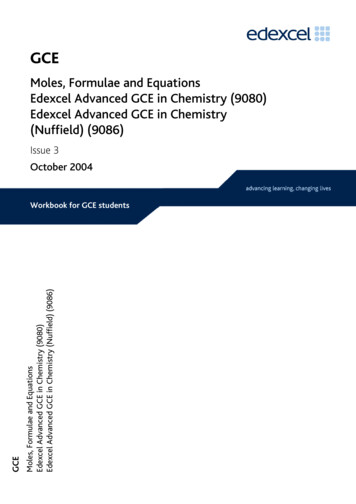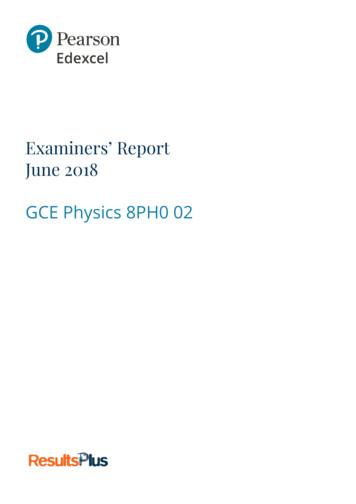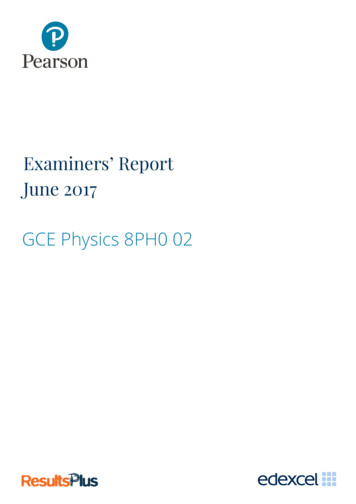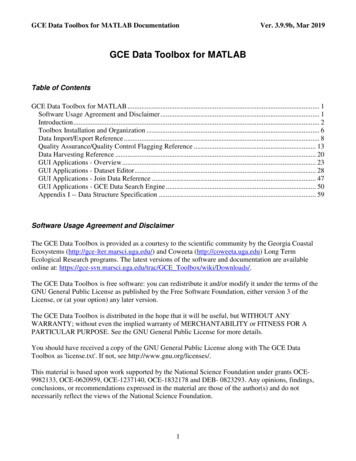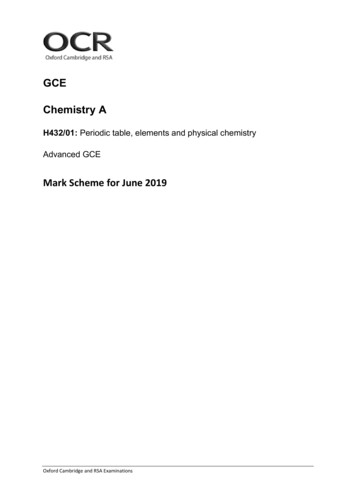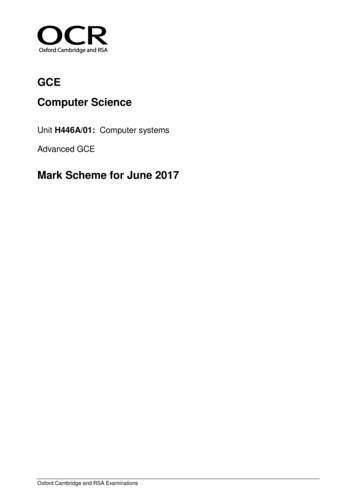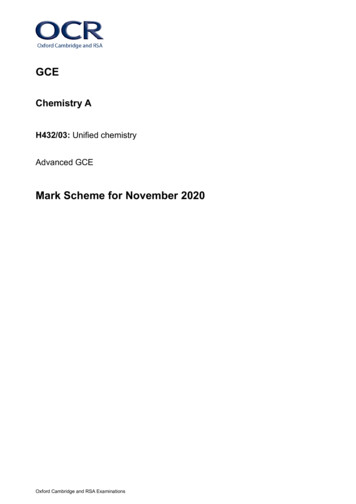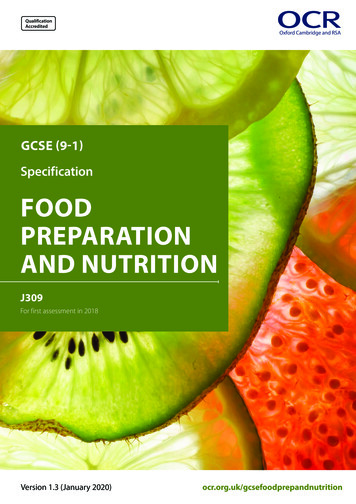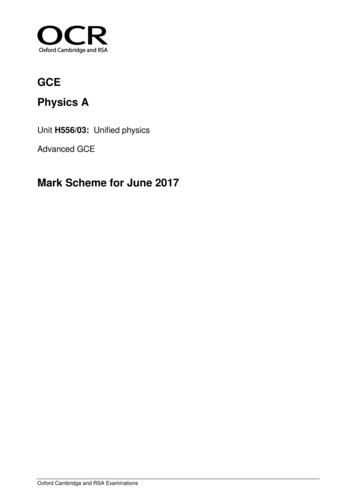
Transcription
GCEPhysics AUnit H556/03: Unified physicsAdvanced GCEMark Scheme for June 2017Oxford Cambridge and RSA Examinations
OCR (Oxford Cambridge and RSA) is a leading UK awarding body, providing a wide range ofqualifications to meet the needs of candidates of all ages and abilities. OCR qualificationsinclude AS/A Levels, Diplomas, GCSEs, Cambridge Nationals, Cambridge Technicals,Functional Skills, Key Skills, Entry Level qualifications, NVQs and vocational qualifications inareas such as IT, business, languages, teaching/training, administration and secretarial skills.It is also responsible for developing new specifications to meet national requirements and theneeds of students and teachers. OCR is a not-for-profit organisation; any surplus made isinvested back into the establishment to help towards the development of qualifications andsupport, which keep pace with the changing needs of today’s society.This mark scheme is published as an aid to teachers and students, to indicate the requirementsof the examination. It shows the basis on which marks were awarded by examiners. It does notindicate the details of the discussions which took place at an examiners’ meeting before markingcommenced.All examiners are instructed that alternative correct answers and unexpected approaches incandidates’ scripts must be given marks that fairly reflect the relevant knowledge and skillsdemonstrated.Mark schemes should be read in conjunction with the published question papers and the reporton the examination.OCR will not enter into any discussion or correspondence in connection with this mark scheme. OCR 2017
H556/03Mark SchemeAnnotations available in ScorisAnnotationMeaningBenefit of doubt givenContradictionIncorrect responseError carried forwardLevel 1Level 2Level 3Transcription errorBenefit of doubt not givenPower of 10 errorOmission markError in number of significant figuresCorrect responseWrong physics or equation3June 2017
H556/03Mark SchemeJune 2017Abbreviations, annotations and conventions used in the detailed Mark Scheme (to include abbreviations and subject-specific LLOW()ecfAWORAalternative and acceptable answers for the same marking pointSeparates marking pointsAnswers which are not worthy of creditAnswers which are not worthy of creditStatements which are irrelevantAnswers that can be acceptedWords which are not essential to gain creditUnderlined words must be present in answer to score a markError carried forwardAlternative wordingOr reverse argument4
H556/03Mark SchemeJune 2017CATEGORISATION OF MARKSThe marking schemes categorise marks on the MACB scheme.B marks: These are awarded as independent marks, which do not depend on other marks. For a B-mark to be scored, the point to which it refersmust be seen specifically in the candidate’s answers.M marks: These are method marks upon which A-marks (accuracy marks) later depend. For an M-mark to be scored, the point to which it refersmust be seen in the candidate’s answers. If a candidate fails to score a particular M-mark, then none of the dependent A-marks can be scored.C marks: These are compensatory method marks which can be scored even if the points to which they refer are not written down by thecandidate, providing subsequent working gives evidence that they must have known it. For example, if an equation carries a C-mark and thecandidate does not write down the actual equation but does correct working which shows the candidate knew the equation, then the C-mark isgiven.A marks:These are accuracy or answer marks, which either depend on an M-mark, or allow a C-mark to be scored.Note about significant figures:If the data given in a question is to 2 sf, then allow to 2 or more significant figures.If an answer is given to fewer than 2 sf, then penalise once only in the entire paper ( except for Q3 where SF are examined).Any exception to this rule will be mentioned in the Additional Guidance.5
H556/03Mark SchemeQuestion1(a)(b)(c)MarksAnswer23892U 42He23490ThB1 .or 42αB1mv (4.00 – 0.0665) x 10-25 x 2.40 x 105 9.44 x 10-20v 9.44 x 10-20/ 6.65 x 10-27 1.42 x 107C1C1k.e. ½ x 6.65 x 10-27 x (1.42 x 107)2 6.70 x 10-13 (J)6.70 x 10-13 /1.60 x 10-13 4.19 (MeV)A1B1ΔA 32 4nα so nα 8ΔZ 10 2nα - nβ so nβ 6B1B1argument/reasoning given for both nα and nβB1Total96June 2017Guidanceallow proton and/or nucleon number to the right ofsymbolallow γ-photon; zero for any other extra particleallow 0.07 x 10-25 for α-particle massmax 3 if use 4.00 instead of 3.93 in momentum eq'nallow ratio of masses 234 and 4 or calculations using234u and 4uallow p2/2m calculation for k.e.accept 4.0 to 4.2; ecf (calculated value of k.e. in J)/eN.B. the correct answer automatically gains all 4 marksallow 8 (decays), i.e no mention of α particlesallow 10 – 16 - 6; NOT 14 – 8 6; must state β(-)particlese.g. change in mass number caused by α decay,change in proton number combination of α and β
H556/03Mark SchemeQuestion2(a)(b)(c)June 2017MarksAnswerGuidanceF Bev and F eEE V/a or F ( eE) eV/aBev eV/a giving V BvaB1B1B1I nAev;v 60 x 10-3/1.2 x 1023 x 1.6 x 10-19 x 5.0 x 0.2 x10-6v 3.1 (m s-1)C1C1A1allow any subject(ii)V 80 x 10-3 x 3.1 x 5.0 x 10-3 1.2 x 10-3 (V)A1ecf (b)(i); allow 1.2 mV; 1.3 x 10-3 (V)(i)Hall probe only compares B-fields/AWor V will be too small/less than 1 mV so not easy tomeasureB1allow any sensible comment, e.g. how do you convert themeasured V into a B valuefind B using F BIl;F is measured by weighing magnets (e.g. placed ontop pan balance assuming wire is fixed);graph of F against I to find B(l) from gradient/AW;B1B1max 4 of the 5 marking pointsalt measure F by adding small masses to wire to return itto zero current positionor use readings of F at several I to find average F/I, etc.greatest uncertainty: measurement of l in B-fieldsensible reason/justification for choosing l or smallmassesB1B1(i)(ii)B1Total 127allow Q or q for eor measurement of small masses in alt. method,etcquantitative suggestion about % error i.e. l small (1 mmin 60) leading to large % uncertainty or difficulty indetermining edge/end of B-field
H556/03Mark SchemeQuestion3(a)(b)M1A1Guidanceallow ln (V/V0) – (t/C).1/R(i)1.10 0.07B1value plus uncertainty required for the mark(ii)two points plotted correctly to within ½ small squareon x-axis;line of best fitgradient ( 15/C) 6.6 (x 104);C 15 / 6.6 x 104 2.3 x 10-4 (F)worst acceptable straight line drawnB1B1ignore accuracy of length of error bar; ecf bi value(C) 0.3 x 10-4 FB1ln(0.1) -15/RC or R -15/C ln(0.1) or R 0.65/CR 0.65/2.3 x 10-4 giving R 28 kΩC1A1(iii)(c)MarksAnswerTake ln to give lnV – (t/C).1/R lnV0gradient (m) (-) t/C where t 15June 2017C1A1B1Total118or both worst acceptable lines drawnaccept 6.4 to 6.8 ignore power of 10accept 2.3 0.1 x 10 -4allow ecf for the point calculated incorrectly in b(ii);steepest or shallowest possible line that passesthrough all the error bars; should pass from top of toperror bar to bottom of bottom error bar or bottom oftop error bar to top of bottom error barallow e.g. (C) 0.2 x 10-4; allow value of C to 4 SFbut N.B. the uncertainty and the value of C must beto the same number of decimal placesallow 230 30 μF etcallow equivalent unit including s Ω-1, C V-1, A s V-1ln(0.1) -2.30ecf (b)(iii)
H556/03Mark SchemeQuestion4(MarksAnswersee page 12June 2017GuidanceB1 x 6a)(b)(i)(ii)1from graph 3.0 (kΩ)I 4.0/3.0 1.33 x 10-3 A or R 2.0/4.0 x 3.0 x 103R (6.0 – 4.0)/1.33 x 10-3 1.5 x 103 (Ω)(ii)2 at 2.4 V RLDR 1.0 kΩB1two arrows needed not across resistor; allow asurrounding circle with arrows outside circleB1C1A1allow 3.1 0.1 (kΩ)accept 1.3 mA; accept potential divider argumentallow 1.5 kΩ;special case: using 2.4 V in place of 4.0 V givesR 4.5 kΩ; give 1 mark out of 2ecf (b)(ii); allow potential divider or I 2.4 mA;for special case: RLDR 9.0 kΩ ; give 1 mark out of 2allow 2.4 to 2.6 W m-2N.B. remember to record a mark out of 5 hereM1giving 2.5 (W m-2)A1Total129
H556/03Question4 (a)Mark SchemeAnswerLevel 3 (5 - 6 marks)Clear planning and correct identification of terminals and positionof componentsMarksB1 x 6June 2017GuidanceUse level of response annotations in RM Assessor,e.g. L2 for 4 marks, L2 for 3 marks, etc.Indicative scientific points may include:There is a well-developed line of reasoning which is clearand logically structured. The information presented is clearrelevant and substantiated.Level 2 (3 – 4 marks)Clear planning and correct identification of some components /terminalsThere is a line of reasoning presented with some structure.The information presented is in the most part relevant andsupported by some evidence.Planning suitable circuit arrangements/diagrams drawn between twopoints which could be connected to the box terminals use of R to limit current, e.g. to find CD terminals logical plan of connection across terminals e.g. connect circuitto each pair of terminals in turn identify terminals C and D as the circuit with the largestcurrent/smallest resistance A and B identified because CD known or the circuit includingterminals AC/D has the smallest current/largest resistanceIdentifying V IR quoted or used in calculations RT R used to determine the 220 or the 470 resistors For 220 Ω resistor (between AB or BC/D) current is 27 (mA) Aor 19 (mA) with R For 470 Ω resistor (between AB or BC/D) current is 13 (mA) or11 (mA) with R For both resistors (between AC/D) current is 8.7 (mA) or 7.6(mA) with R For wire (between CD) current is 0.060 ALevel 1 (1 – 2 marks)Some planning and/or an attempt at identifying component /terminalsThere is an attempt at a logical structure with a line ofreasoning. The information is in the most part relevant.0 marksNo response or no response worthy of credit.10
H556/03Mark SchemeQuestion5((i)(b)MarksAnswersin or cos wave with 1.5 wavelengths (between C and R)ay-axis showing scale ,i.e. (amplitude) 2.(0) x 10-6 (m))correct scale on x-axis showing λ 0.2 (m)X and Y labelled at adjacent intercepts on x-axisB1B1B1B1(ii)1v Aω or 2πfAv (2 x 10-6 x 2 x 3.14 x 1.7 x 103 ) 2.1 x 10-2 (m s-1.)C1A1(ii)2½Mv2 3/2 RT and T 290v (3 x 8.31 x 290/0.029)v 5(.0) x 102 (m s-1.)C1A1see page 14B1 x 6Total1114June 2017Guidanceunit must be present, e.g 10-6 mNOT if axis labelled timeor ½mv2 3/2 kT so v2 3 (k/m) 290N.B. remember to record a mark out of 4 here
H556/03Question5 (b)Mark SchemeAnswerMarksB1 x 6Level 3 (5 - 6 marks)Clear description and explanation for both experimentsand some discussion of uncertaintyJune 2017GuidanceUse level of response annotations in RM Assessor,e.g. L2 for 4 marks, L2 for 3 marks, etc.Indicative scientific points may include:There is a well-developed line of reasoning which is clearand logically structured. The information presented is clearrelevant and substantiated.Level 2 (3 – 4 marks)Some description and explanation for both experiments orclear description and explanation for one experiment andsome discussion of uncertaintyThere is a line of reasoning presented with some structure.The information presented is in the most part relevant andsupported by some evidence.Level 1 (1 – 2 marks)Limited description and explanation for one experimentThere is an attempt at a logical structure with a line ofreasoning. The information is in the most part relevant.Description and explanationExperiment (a) Coherent signals/(sound) waves Interference / superposition Maximum signal / minimum signal Idea of how wavelength is determined (e.g. distance betweenadjacent max positions ) v f Experiment (b) Stationary/standing wave produced Superposition of waves travelling in opposite directions Nodes / antinodes Idea of how wavelength is determined (e.g. distance betweenadjacent nodes /2) v f Uncertainty 0 marksNo response or no response worthy of credit. 12Measure multiples of to reduce % uncertainty (by factor n)move from minimum signal to minimum signalso can increase sensitivity of scope to get better fix on eachminimum position/ increase loudness from speakerLower frequency from signal generatorso increases λ with (%) uncertainty reducedDo experiment outsideto reduce background reflections from room (so that sharperminima should be observed)
H556/036Mark SchemeQuestion((b)(i)MarksAnswerarrow down through centre of ball labelledaweight or W or mg or 1.2 N)(horizontally) mv2/r (or mrω2) T sin θand (vertically) W or mg T cos θJune 2017Guidancezero if any other arrows or forces presentB1M1accept figures in place of algebra, r 0.045 mv 0.42 m s-1 ω 3π rad s-1; rω2 4.0 m s-2 ;W 1.2 N and m 0.12 kg and mrω2 0.48 Naccept labelled triangle of forces diagramN.B. this is a show that Q ; sufficient calculation mustbe present to indicate that the candidate has not workedback from the answer(tan θ v2/rg or rω2/g)tan θ 0.045 x 4 x 9.87 x 2.2/9.81 or 0.48/1.2 ( 0.40)θ 22oA1A0k (mg/x0 1.2 / 0.050) 24 (N m-1)(T mg / cos θ kx giving) x 1.2 / 24 cos 22x 0.054 (m )C1C1A1or solution by ratios(c)(y ½gt2 ) 0.18 0.5 x 9.81 x t2giving t 0.19 (s)(x vt ) 0.42 x 0.19 0.08 (m)distance (r2 x2) (0.0020 0.0064) 0.092 (m)C1C1C1A1alt: projectile motion: x vt, y ½gt2y ½g(x/v)2ecf (b)i for v; x2 2yv2/g 2 x 0.18 x 0.422/9.81(d)T increases or string stretches or angle θ increasesM1to provide/create a larger centripetal forceA1(ii)Total1312allow mv2/r or mrω2 in place of centripetal forcecausality must be implied to gain the A mark
OCR (Oxford Cambridge and RSA Examinations)1 Hills RoadCambridgeCB1 2EUOCR Customer Contact CentreEducation and LearningTelephone: 01223 553998Facsimile: 01223 552627Email: general.qualifications@ocr.org.ukwww.ocr.org.ukFor staff training purposes and as part of our quality assuranceprogramme your call may be recorded or monitoredOxford Cambridge and RSA Examinationsis a Company Limited by GuaranteeRegistered in EnglandRegistered Office; 1 Hills Road, Cambridge, CB1 2EURegistered Company Number: 3484466OCR is an exempt CharityOCR (Oxford Cambridge and RSA Examinations)Head officeTelephone: 01223 552552Facsimile: 01223 552553 OCR 2017
Unit H556/03: Unified physics Advanced GCE Mark Scheme for June 2017. OCR (Oxford Cambridge and RSA) is a leading UK awarding body, providing a wide range of . indicate the details of the discussions which took place at an examiners' meeting before marking . 5 mv (4.00 - 0.0665) .
